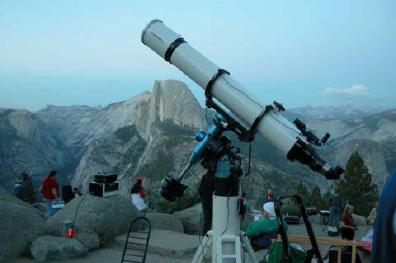California Vacation Astronomy Highlights
Dave Wagner
Part II - Yosemite

Last month I shared our visit to the Lick Observatory, and their Summer Visitors Program. This month I will share our visit to Yosemite's Glacier Point, in the Sierra Nevada Mountains of California.
Glacier Point is a beautiful overlook; 3200 feet above Yosemite Valley (7215 feet in altitude), a comfortable 16-mile drive from Hwy 41. We arrived in plenty of time to catch the ranger twilight talk as the sun set behind us, and members of a local astronomy club set up in the amphitheater area.
As the ranger explained it, he teaches astronomy, and was hired some years ago by the park service because Yosemite lacked a 'Night Sky' program. He took it one step further by bringing his SCT up to the point, so in addition to talking about the constellations; he could share some telescopic views of the moon, planets and other objects. That worked well for a while, but one night there were 200 observers and just his one telescope! As a result he made arrangements with local astronomy clubs, that in exchange for free admission and camping (and setting their telescopes up on a GREAT site), they put on a Friday and Saturday star party. Everyone wins.
The group started just after dusk with a general program about the planets, and other night sky objects, a general speech on white light, what not to touch on the telescopes, etc until dark. The ranger got out his green laser and did his constellation talk, and then back to the telescopes for more observing.
So lets talk about dark skies...
Our dark site in Hebron maps out on the Bortle scale as a 5. That is described as "Milky way washed out at zenith and invisible at horizon. Many light domes. Clouds are brighter than sky. M31 easily visible. Limiting magnitude about 5.6 to 5.9". At Mt. Hamilton from last months article, the Bortle scale puts it at a 4.5. That is described as "Some dark lanes in milky way but no bulge into Ophiuchus. Washed out Milky Way visible near horizon. Zodiacal light very rare. Light domes up to 45 degrees. Limiting magnitude about 5.9 to 6.2".
Now we have Yosemite skies... a Bortle of 1 (best possible). That is described as "The zodiacal light, gegenschein, and zodiacal band are all visible - the zodiacal light to a striking degree, and the zodiacal band spanning the entire sky. Even with direct vision, the galaxy M33 is an obvious naked-eye object. The Scorpius and Sagittarius region of the Milky Way casts obvious diffuse shadows on the ground. To the unaided eye the limiting magnitude is 7.6 to 8.0 (with effort); the presence of Jupiter or Venus in the sky seems to degrade dark adaptation. Airglow (a very faint, naturally occurring glow most evident within about 15 degrees of the horizon) is readily apparent. This is an observer's Nirvana!"
The view was unreal. Areas of the sky near big dipper, normally relatively sparse in star density were heavy with stars. The Milky Way literally lit the area with its glow. With the aid of binocular (perhaps without if I had better eyes) I could clearly see the complete oval of the Andromeda galaxy, out to the limits of the binocular FOV. Dust lanes in the Milky Way were outstanding. The stars seem bluer and sharper than I had ever seen, piercing their points in the sky. We had a fair share of meteors also, occuring every 3-6 minutes. If you didn't see one by then, you certainly would have heard a group 'oh wow!' from some other end of the point. When a brighter meteor swept across the sky, you could see the glow of its path for many seconds after it was consumed. Using a telescope seemed almost superfluous with all the wonderful beauty all around. My wife and I lay on the ground for an hour just soaking it in like it was warm sunshine. What a view.





